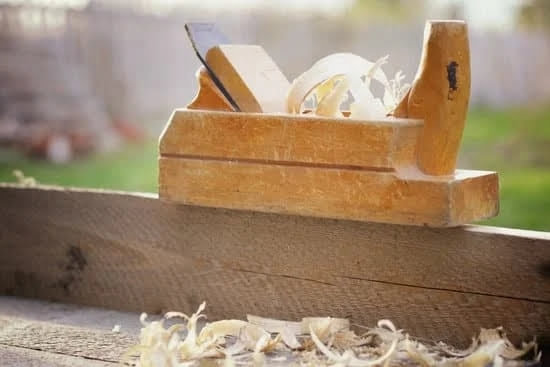What is a beading cutter in woodworking? Beading cutters are essential tools used in woodworking to create decorative edges, grooves, and designs on wooden surfaces. They come in various shapes and sizes, each serving different purposes in woodworking projects. In this article, we will explore the history, types, uses, proper techniques, tips, and maintenance of beading cutters to help you understand their importance and achieve the best results in your woodworking endeavors.
Beading cutters have been an integral part of woodworking for centuries and have evolved to become indispensable tools in creating intricate designs and patterns on wood. Understanding the history of beading cutters and their significance in woodworking will provide insight into their versatility and value as essential instruments for woodworkers.
In addition to delving into the history of beading cutters, we will also discuss the different types available and how they are used. Learning about the variety of beading cutters and their specific uses will enable woodworkers to select the right tool for their projects and achieve optimal results. Whether it’s creating simple decorative edges or intricate patterns, using the appropriate beading cutter is crucial for achieving precision in woodworking.
The History of Beading Cutters and Their Importance in Woodworking
Beading cutters have been an essential tool in woodworking for centuries, dating back to the ancient Egyptians who used bronze tools to create intricate designs on wooden furniture. The use of beading cutters has evolved over time, with advancements in technology and craftsmanship leading to the development of various types of beading cutters with enhanced precision and efficiency.
The importance of beading cutters in woodworking cannot be understated, as they allow woodworkers to add decorative edges and detailing to their projects, creating a professional and polished finish. Whether it’s adding a simple rounded edge or creating intricate patterns, beading cutters offer woodworkers the versatility and creativity to enhance their creations.
In modern woodworking, beading cutters are commonly used in furniture making, cabinetry, and trim work. They are also popular among hobbyists and DIY enthusiasts who want to elevate the aesthetic appeal of their woodworking projects. With a wide range of profiles and sizes available, woodworkers can choose the perfect beading cutter for their specific design needs.
Understanding the Different Types of Beading Cutters and Their Uses
Beading cutters come in a variety of types, each with its own specific uses and benefits. Understanding the different types of beading cutters can help woodworkers choose the right tool for their projects and achieve the desired results.
Types of Beading Cutters
There are several types of beading cutters commonly used in woodworking. The most common types include the classical beading cutter, radius beading cutter, corner beading cutter, and combination beading and fluting cutter. Each type is designed to create a specific profile or shape in the wood, ranging from simple rounded edges to more intricate designs.
Uses of Beading Cutters
Beading cutters are used to create decorative edges on wooden workpieces, such as furniture, cabinets, and molding. They can also be used to make grooves or channels in the wood for both functional and aesthetic purposes. By choosing the right type of beading cutter, woodworkers can add texture and detail to their projects, enhancing their overall appearance.
Woodworkers should consider factors such as the size of the workpiece, the type of wood being used, and the desired outcome when selecting a beading cutter for their project. It’s important to understand the characteristics and capabilities of each type of beading cutter in order to make informed decisions about which one is best suited for a particular woodworking task.
How to Properly Use a Beading Cutter in Woodworking Projects
Understanding the Function of Beading Cutters
Beading cutters are woodworking tools that are specifically designed to create decorative edges and profiles on wooden surfaces. These cutters are equipped with a rounded cutting edge that allows them to create semi-circular or rounded profiles, adding visual interest and detail to the woodwork. They can be used to produce various types of decorative details such as beads, reeds, and flutes on wood surfaces.
Proper Setup and Safety Measures
Before using a beading cutter, it is crucial to ensure that it is securely installed in a router or a spindle molder. The depth and position of the cutter also need to be accurately adjusted according to the desired profile. Additionally, wearing appropriate personal protective equipment such as safety goggles, ear protection, and dust masks is essential when operating woodworking machinery.
Techniques for Using Beading Cutters
When using a beading cutter in woodworking projects, it is important to feed the wood steadily into the cutter at an even pace. This will help in achieving a smooth and consistent profile across the entire length of the workpiece. It is also recommended to make test cuts on scrap wood before working on the actual project to ensure that the depth and position of the cutter are set correctly.
Overall, understanding how to properly use a beading cutter in woodworking projects is essential for achieving professional-looking results and adding decorative elements to wooden surfaces.
Tips and Techniques for Achieving the Best Results With Beading Cutters
When it comes to achieving the best results with beading cutters in woodworking projects, there are several tips and techniques that can help woodworkers create clean, precise, and professional-looking beadwork. One key tip is to always select the right beading cutter for the specific task at hand. Different types of beading cutters are designed for different profiles and sizes of beads, so choosing the appropriate cutter is essential for achieving the desired result.
In addition, it is crucial to pay attention to the direction of the wood grain when using a beading cutter. By understanding how the wood grain interacts with the cutter, woodworkers can minimize tear-out and achieve a smoother finish on their beaded edges. Another important technique is to take light passes with the beading cutter, especially when working with hardwoods. This can prevent tear-out and splintering while ensuring a more controlled and precise cut.
Furthermore, maintaining sharpness in beading cutters is vital for achieving high-quality results. Keeping the blades sharp through regular sharpening or replacement will not only improve the quality of beadwork but also extend the longevity of the cutting tool itself. By following these tips and techniques, woodworkers can consistently achieve exceptional results with their beading cutters, enhancing the overall craftsmanship of their woodworking projects.
| Tips | Techniques |
|---|---|
| Select the right beading cutter for each task | Pay attention to wood grain direction |
| Take light passes when using a beading cutter | Maintain sharpness in beading cutters |
Common Mistakes to Avoid When Using Beading Cutters
When using beading cutters in woodworking projects, it is important to be mindful of common mistakes that can compromise the quality of the finished product. Avoiding these mistakes can help ensure that your work turns out as intended, and that you make the most out of your beading cutter. Here are some common mistakes to avoid when using beading cutters:
- Incorrect Speed: One common mistake when using a beading cutter is running it at the wrong speed. It’s important to adjust the speed of the cutter according to the type of wood and the size of the bead being cut. Running at too high or too low a speed can result in rough cuts or even damage to the wood or the cutter itself.
- Improper Depth Setting: Another mistake to avoid is setting the depth of cut incorrectly. If the depth is set too shallow, it may not create a deep enough bead. Conversely, if it’s set too deep, it could cause tear-out and lead to an uneven finish.
- Using Dull Cutters: Using dull or damaged cutters can result in poor quality cuts and can put unnecessary strain on your woodworking tools. Regularly inspect and replace your cutters as needed to ensure clean and precise cuts.
In order to achieve the best results with your beading cutter, it’s important to pay attention to these details and take care to avoid these common mistakes.
Remember that mastering how to properly use a beading cutter not only will improve your woodworking skills but also will extend its efficiency and longevity.
By keeping an eye out for these potential pitfalls, you’ll be able to use your beading cutter more effectively and achieve better results in your woodworking projects.
Maintenance and Care of Beading Cutters for Longevity and Efficiency
Beading cutters are essential tools in woodworking, allowing craftsmen to create decorative edges and moldings on their projects. To ensure the longevity and efficiency of these valuable tools, proper maintenance and care are necessary. By following a few simple steps, woodworkers can keep their beading cutters in optimal condition for years to come.
One of the most important aspects of maintaining beading cutters is keeping them clean and free from debris. After each use, it is crucial to remove any sawdust, resin, or other buildup from the cutter. This can typically be done using a stiff brush or compressed air to dislodge any particles that may have accumulated during the cutting process. Additionally, a thorough cleaning with a specialized solvent may be necessary for more stubborn residue.
In addition to cleanliness, it is important to inspect the cutting edges of the beading cutter regularly. Over time, these edges can become dull or worn down, impacting the quality of cuts and potentially causing safety hazards. By using a magnifying glass or similar tool, woodworkers can closely examine the edges for any signs of damage or wear.
If issues are discovered, sharpening or replacing the cutter may be necessary to maintain its effectiveness. Regular inspection and maintenance of cutting edges will ensure that the beading cutter continues to produce crisp and precise results in woodworking projects.
Exploring Creative Ways to Incorporate Beading Cutters in Woodworking Projects
Beading cutters are a versatile tool in woodworking that can be used in a variety of creative ways to add decorative and functional details to wood projects. Whether you are a seasoned woodworker or just starting out, there are several innovative ways to incorporate beading cutters into your projects. Here are some ideas for using beading cutters in woodworking:
- Creating decorative edges: Beading cutters can be used to create decorative edges on furniture, cabinets, or picture frames. By running the beading cutter along the edge of the wood, you can add a unique and stylish detail that will enhance the overall look of your project.
- Making custom moldings: Instead of purchasing pre-made moldings, consider using a beading cutter to create custom moldings for your woodworking projects. This allows you to achieve a personalized look and fit for your specific project.
- Designing intricate patterns: Beading cutters can also be used to design intricate patterns on wood surfaces. By carefully planning the placement and direction of the cuts, you can create eye-catching designs that will make your project stand out.
- Adding texture and dimension: Another creative way to use beading cutters is to add texture and dimension to flat surfaces. By varying the depth and spacing of the cuts, you can create tactile elements that bring visual interest to your woodworking projects.
By exploring these creative ways to incorporate beading cutters in woodworking projects, you can take your craftsmanship to the next level and create truly unique pieces. Experiment with different techniques and designs to discover how this versatile tool can enhance your woodworking skills and projects.
Conclusion
In conclusion, beading cutters are an essential tool in woodworking that have been used for centuries. Their history and importance in shaping wood and creating intricate designs cannot be overstated. Understanding the different types of beading cutters and how to properly use them is crucial for achieving the best results in woodworking projects.
When using a beading cutter, it is important to follow proper techniques and avoid common mistakes to ensure safety and precision. Additionally, regular maintenance and care of beading cutters will prolong their longevity and efficiency, ultimately saving time and money in the long run.
Overall, the versatility of beading cutters allows woodworkers to explore creative ways to incorporate them into various projects, from simple trims to more elaborate designs. The value of these tools lies in their ability to add unique details and textures to woodworking projects, making them a valuable asset for both beginners and experienced craftsmen alike.
Whether it’s for creating decorative edges or adding a touch of elegance to furniture pieces, beading cutters are an indispensable tool in the world of woodworking.
Frequently Asked Questions
What Is a Beading Tool Used For?
A beading tool is used for creating decorative edges on wood, metal, or other materials. It typically consists of a small, rounded blade that is used to cut a semi-circular groove or bead into the surface of the material. This can add visual interest and texture to the piece being worked on.
What Is Beading in Woodworking?
In woodworking, beading refers to the process of adding decorative beaded edges to a piece of wood. This can be done using hand tools such as chisels or specialized planes, or with power tools such as routers. The resulting beaded edge can enhance the appearance of furniture, moldings, and other wooden objects.
What Is Beading Used For?
Beading is used for various decorative and functional purposes in woodworking and other crafts. It can add detail and visual appeal to furniture, cabinets, picture frames, and other wooden items.
Beads can also serve as a design element for jewelry-making and can be incorporated into metalwork as well. Overall, beading is a versatile technique that offers creative possibilities in various artistic disciplines.

Hi everyone! I’m a woodworker and blogger, and this is my woodworking blog. In my blog, I share tips and tricks for woodworkers of all skill levels, as well as project ideas that you can try yourself.





